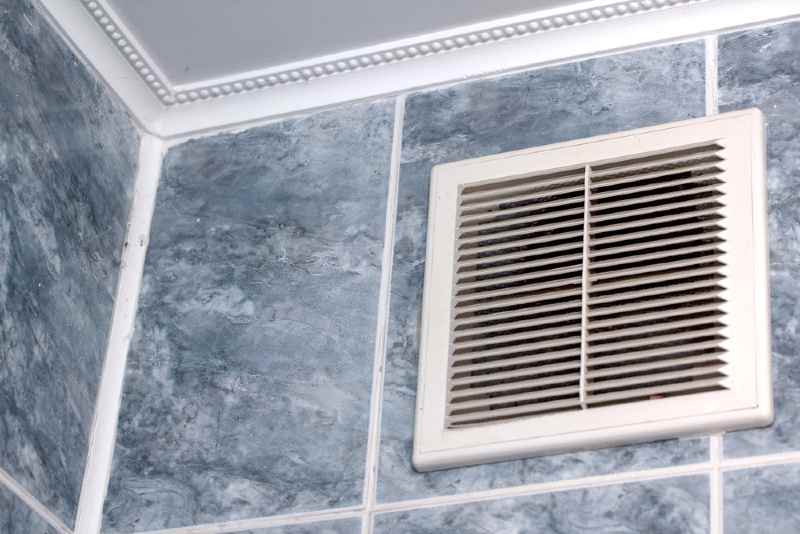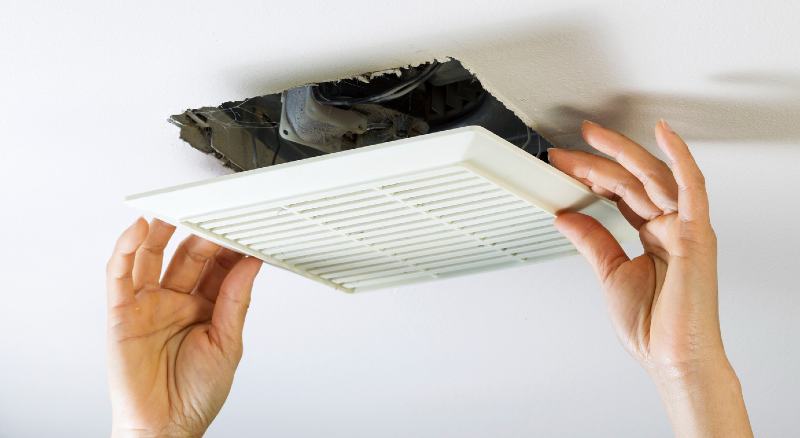Leaking household fixtures are always a concern. A common area for a household leak is your bathroom’s ceiling fan vent. Many people notice this ceiling leak from a bathroom exhaust fan during a heavy rainstorm. Unfortunately, the leak can be a sign of many different issues. In this article, we’ll help you identify the root cause so you can put a stop to it.
Bathroom Vent Leaking Water When it Rains
In general, a leaking bathroom vent is a sign of two broad issues.
The first issue that might cause a bathroom fan leak occurs when the contractor improperly installed the fan or ducting, allowing water to enter the bathroom from the roof. Because your bathroom vent pipe connects to the outside of your home, improper installation can result in water traveling inside the home (instead of outside).
The second issue may be condensation building in the ducts. Often, this issue isn’t related to rainfall but is instead related to a fan that isn’t properly clearing your vents of moisture.
Let’s jump on your roof and into your attic and break down these two issues in detail. If a picture is worth a thousand words, a video is worth a million.
Table of Contents
- Bathroom Vent Leaking Water When it Rains
- Bathroom Vent Leaking Water When it Rains – What’s Causing It?
- Faulty Venting System – Water from Roof Entering Home
- Other Potential Issues
- Call a Professional
- Conclusion
Bathroom Vent Leaking Water When it Rains – What’s Causing It?
Here are the potential causes for the problem, be sure to read on for common solutions.
Faulty Venting System – Water from Roof Entering Home
Your air vent is designed to allow moisture and warm air to escape your bathroom, but not the other way around. Unfortunately, if your builder improperly installed your bathroom fan or venting system, you can experience reverse flow when it rains. Several areas of a venting system can malfunction, including the following:
Faulty Damper Flap
First, check your vent flap (or damper flap) on the outside of your home. It should only allow one-way traffic to the outside of your house. The vent flap’s job is to allow warm air to escape and remain closed at other times to prevent outside moisture from entering. Rust, corrosion, or poor installation could all cause the damper flap to stick open. The damper may also have dislodged completely, or it may need to be tightened.
The damper flap should be one of the first things you check in the event of a bathroom fan leak, as it acts as a primary line of defense against outside moisture.
Sealant Connecting Venting System
A vent ducting system connects your bathroom fan to your roof. For the system to work properly, the builder must properly seal the air vent and the air vent cover. This will prevent moisture from entering the seams.
You’ll need to check the sealant at the seams, especially where the vent connects to the roof. The worst-case might require you to fully reinstall and re-seam the ducting system. This might also include replacing the shingles where the vent attaches to the roof.
Faulty Bathroom Fan
Your bathroom fan is designed to use its power to take moisture from your bathroom to the outside of your home. Therefore, if this fan is not working properly, it might struggle to clear the condensation that gathers in your vents. Because the vent is vertical, this moisture can then travel back down your vents, resulting in a “leak” out of the vent itself. Here are some common issues that might occur with your bathroom fan:
Fan is Not Powerful Enough
The bathroom fan needs enough power to clear your bathroom of moisture in the air, and it also needs enough power to take the air through your ventilation to the outside of your home. Therefore, if your bathroom is bigger, or if the venting leading to your roof is longer, then you will need a more powerful exhaust fan. Otherwise, the exhaust fan may not have the power to take moisture from your bathroom and through your vents, resulting in moisture that falls back down your vents.
Check to be sure that your fan is properly “rated” to clear your room. Fans are given ratings according to CFM (Cubic Feet per Minute). This is the number of cubic feet that the fan can clear in one minute. Of course, you’ll want to match this rating to the cubic feet in your room. If your fan is too weak, you may need to replace it.
Even if your bathroom exhaust fan is properly rated, it may still struggle if your ventilation system is particularly long, or if your bathroom is very prone to excess moisture (you take extra hot showers, your bathroom has no windows, you run the faucet a lot, etc.) This may also be the case if your bathroom has particularly high ceilings.

Is Your Fan Doing Its Job?
Fan Is Faulty
Similar to the issue above, your fan may not be generating enough power because it is faulty. It may simply be that your fan is old and needs to be replaced. Additionally, it may be of particularly low quality, or you may have received a defective unit. Your fan will need to be replaced in this instance.
See if your fan is covered under warranty, especially if it’s still relatively new. A fan should not be defective within the first few years of owning. This also shows the importance of buying a quality device.
Fan Not Running for Enough Time
Another issue may be with how long you are allowing the exhaust fan to run. If your bathroom is particularly full of moisture, such as after you’ve taken a shower, then you need to get in the habit of allowing the fan time to clear the room. On average, it takes a fan about 15 minutes to fully clear a humid room after a shower.
Fan Location – Improperly Installed
Even if your fan is properly rated for your room, it might be an issue where you have installed the fan in your bathroom. Fans shouldn’t be installed in an area with a particularly high moisture concentration, such as directly above a shower. This is because the hot air directly hits the colder ventilation system, which cools the air creating even more moisture, and making it more difficult for the fan to clear all that moisture. The fan should be located in a different section of the bathroom, to give the air some space to cool off.

Other Potential Issues
There may be other issues causing your vent – or other areas of your roof – to leak. These issues might be quite a bit more complicated, and expensive, to fix. If you’ve ruled out the above problems, then you might need to start looking elsewhere:
Poor Insulation
Poor insulation in your home might be causing water to leak from your roof. This can be the case when the heat is allowed to escape through your roof. If there is ice on your roof, this warm air can melt the ice, causing water to enter through your roof.
Issue with the Roof
There’s always the possibility that the leaks in your vent aren’t an issue with your venting or fan at all. They could be an indication of a larger problem with your roof. Of course, this is quite a major issue and will require a professional to diagnose and fix the problem for you. If your roof is leaking, then you have a pretty major fix on your hands.
This professional can also diagnose whether your venting is properly connected to your roof and that it is properly insulated at the seams.
Call a Professional
We gave you several common causes that can lead to your bathroom vent leaking, whether it’s raining or not. We also ran down solutions for each issue. However, these issues can be very complicated to diagnose and fix. If you’re struggling to identify the issue, then we recommend you contact a professional.
A professional can properly determine the source of the issue so that you don’t misdiagnose the problem and direct your efforts to the wrong solution. An expert will also ensure the job is done correctly. When dealing with extra-sensitive parts of your home, such as your roof – particularly the ridge vent – and venting systems, it will require an expert-level knowledge of these areas. If you aren’t comfortable handling this yourself, then an expert should be contacted.
Conclusion
Thanks for reading our guide to your leaky bathroom vent. Unfortunately, this problem can occur for many different reasons, making it tricky to address the issue. Use our guide to determine what is wrong with your bathroom vent. Remember, there’s no shame in calling a professional to handle it for you!

